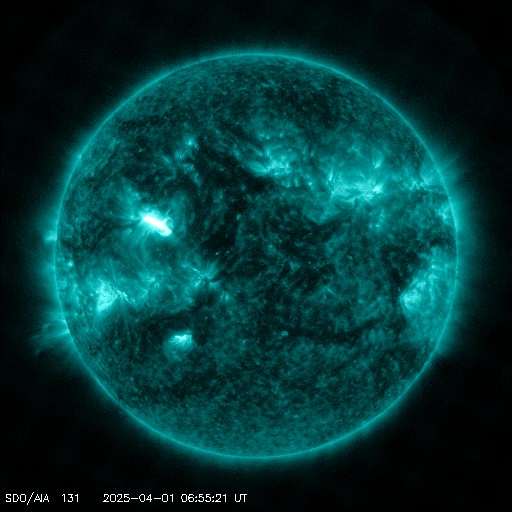Viewing archive of Thursday, 29 March 2001
Solar activity report
Any mentioned solar flare in this report has a scaling factor applied by the Space Weather Prediction Center (SWPC). Because of the SWPC scaling factor, solar flares are reported as 42% smaller than for the science quality data. The scaling factor has been removed from our archived solar flare data to reflect the true physical units.
Report of Solar-Geophysical Activity 2001 Mar 29 2200 UTCPrepared by the NOAA © SWPC and processed by SpaceWeatherLive.com
Joint USAF/NOAA Report of Solar and Geophysical Activity
SDF Number 088 Issued at 2200Z on 29 Mar 2001IA. Analysis of Solar Active Regions and Activity from 28-2100Z to 29-2100Z
Solar activity was high. Region 9393 (N17W18) produced
an X1/1N event at 29/1015Z. This event had an associated Type IV
radio sweep, a tenflare of 4700 sfu, and a full halo CME was
reported from LASCO/SOHO imagery. This earth-directed CME occurred
at approximately 29/1030Z. Region 9393 also produced numerous minor
M-class events during the period. Region 9393 has shown slight
growth in area since yesterday and is currently over 2400 millionths
in white light. No new regions were numbered today.
IB. Solar Activity Forecast
Solar activity is expected to be high.
Region 9393 still has the best potential to produce a major flare.
IIA. Geophysical Activity Summary 28-2100Z to 29-2100Z
The geomagnetic field was quiet to minor storm. The greater than 10
MeV protons crossed the 10 pfu event threshold at 29/1635Z and has
not yet peaked (highest flux observed so far was 18 pfu at
29/2050Z).
IIB. Geophysical Activity Forecast
The geomagnetic field is
expected to increase during the first day of the period to active to
major storms levels due to a CME passage. The passage of a faster
CME, from the X1 event today, may occur later on the first day.
With the passage of the second CME, conditions are expected to be at
active to major storm levels with isolated severe conditions
possible. During the last half of the period, conditions are
expected to decrease to unsettled to active conditions. CME passage
could increase the strength and duration of the 10 MeV proton event
currently in progress. Another proton event is possible, and likely
stronger, if Region 9393 produces another major flare as it transits
the solar western hemisphere.
III. Event Probabilities 30 Mar to 01 Apr
| Class M | 80% | 80% | 80% |
| Class X | 30% | 30% | 30% |
| Proton | 99% | 30% | 30% |
| PCAF | yellow | ||
IV. Penticton 10.7 cm Flux
Observed 29 Mar 262 Predicted 30 Mar-01 Apr 260/255/250 90 Day Mean 29 Mar 163
V. Geomagnetic A Indices
Observed Afr/Ap 28 Mar 019/031 Estimated Afr/Ap 29 Mar 020/025 Predicted Afr/Ap 30 Mar-01 Apr 045/050-045/050-025/030
VI. Geomagnetic Activity Probabilities 30 Mar to 01 Apr
| A. Middle Latitudes | |||
|---|---|---|---|
| Active | 30% | 20% | 40% |
| Minor storm | 40% | 50% | 30% |
| Major-severe storm | 20% | 25% | 15% |
| B. High Latitudes | |||
|---|---|---|---|
| Active | 20% | 10% | 30% |
| Minor storm | 40% | 40% | 40% |
| Major-severe storm | 30% | 40% | 20% |
All times in UTC
Current data suggests there is a slight possibility for aurora to appear at the following high latitude regions in the near future
Whitehorse, YT, Yellowknife, NTFairbanks, AK
Latest news
Latest forum messages
Similar AR 3664 vs AR 4048 ??? 7AR4046 143AR4048 60Temporary Topic - Ongoing Solar Proton Events 5Unspecified geomagnetic activity 2176
More topicsSupport SpaceWeatherLive.com!
A lot of people come to SpaceWeatherLive to follow the Sun's activity or if there is aurora to be seen, but with more traffic comes higher server costs. Consider a donation if you enjoy SpaceWeatherLive so we can keep the website online!

Latest alerts
07:15 UTC - 10cm Radio Burst
Begin Time: 01/04/2025 06:45 UTC Maximum Time: 01/04/2025 06:45 UTC Duration: 1 minutes. Peak flux: 190 sfu
07:06 UTC - Solar flare
Strong M5.61 flare
06:48 UTC - Radio Blackout
Moderate R2 radio blackout in progress (≥M5 - current: M5.36)
06:45 UTC - Radio Blackout
Minor R1 radio blackout in progress (≥M1 - current: M1.7)
02:15 UTC - Solar protons
Moderate S2 Solar Radiation Storm - Infrequent effects on HF radio through polar regions and satellite operations
Space weather facts
| Last X-flare | 2025/03/28 | X1.1 |
| Last M-flare | 2025/04/01 | M5.6 |
| Last geomagnetic storm | 2025/03/27 | Kp5 (G1) |
| Spotless days | |
|---|---|
| Last spotless day | 2022/06/08 |
| Monthly mean Sunspot Number | |
|---|---|
| February 2025 | 154.6 +17.6 |
| Last 30 days | 128.5 -22.7 |



